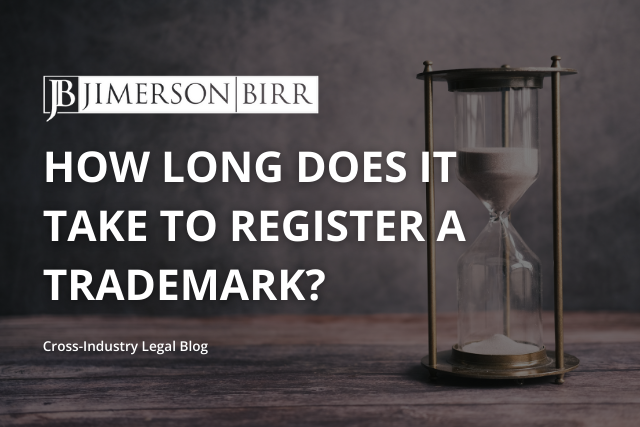Clients often want to know how long it takes to register a trademark. The short answer is that it can take anywhere from a few months to several years. The good news is that many of the variables affecting how long it takes for a trademark application to mature to registration are in your hands.
Before breaking down the factors that can affect how long it takes a trademark application to mature, it’s helpful to point out that the United States Patent and Trademark Office (USPTO) publishes average processing times on its website at Trademark processing wait times | USPTO and Trademarks Dashboard | USPTO. As I write this blog, the USPTO is reporting an initial wait time between filing and receiving a first action of about 6 months and an average time to registration or abandonment of an application of about a year. But those numbers are deceiving, and the process is not one size fits all.
The first, and oftentimes the most important, factor affecting how long a trademark application takes to mature to registration is the filing basis. Most U.S. trademark applications are filed under Section 1(a) or Section 1(b) of the Trademark Act, respectively, based on use or intent to use in commerce.
A trademark application based on use in commerce under Section 1(a) is just what it sounds like; namely, that the applicant has already started using the trademark in United States commerce when the application to register the mark is filed. If your application is based on use in commerce, if the USPTO has no objection to your application maturing to registration, and if there aren’t any public oppositions filed, your application could mature to registration in as little as perhaps 9 months.
However, if you decide to take advantage of Section 1(b) by filing an intent to use based application, your application will not register unless and until you file a Statement of Use and a Specimen of Use showing that you have begun making use of the mark in commerce. Once your application clears USPTO review and clears the Publication period (discussed below), the USPTO will issue a Notice of Allowance. That document provides an effective all-clear to register once you establish use and gives you a 6-month window to do so, or to seek an extension of time. Applicants have five 6-month extensions of time available to them. As such, an applicant can delay registration for as long as 3 years after the Notice of Allowance issues. This is often a very appealing strategy for businesses with a long ramp-up time since the trademark priority date tacks back to the date of your intent to use based application once the application matures to registration. In the meantime, anyone who seeks to apply to register a confusingly similar trademark after you filed your application (even if they’ve started using the mark in commerce before you get your registration) would be blocked from registering their mark due to your earlier filing. So, in this case, a long delay between application and registration can be a strategic advantage.
Other common factors that delay registration are Office Actions. Office Actions are USPTO objections to registration. These vary widely. Some are simple technicalities, such as inconsistencies in your application. Others can be substantive, like the likelihood of confusion with a prior registered trademark. And still others can be subtly technical, like translation requirements, which should be thoughtfully handled to avoid the unexpected or undesirable likelihood of confusion determinations after an initial probability of confusion decision has been cleared by the USPTO examiner. Whatever the case, applicants typically have 3 months to respond to an Office Action before the application is abandoned. If you respond to the Office Action promptly, the USPTO can either resolve the objection or maintain it with a second/Final Office Action. At this point, most applicants elect to abandon the application or to file an appeal. USPTO examiners rarely change their minds on a request for reconsideration (a response to a Final Office Action). In most cases, the only reason to file one is to add evidence to the record since an appeal is typically limited to the evidence in the examination file.
Sometimes, an applicant will respond to an Office Action, and the USPTO examiner will issue a second Office Action with a new topic. In that case, the second Office Action is treated as a “first” Office Action for response and appeal.
If you choose to appeal a refusal to register, it can take 6 to 12 months (or longer) for that appeal to be decided by the Trademark Trial and Appeal Board (the TTAB).
Once all Office Action and appeals issues have been cleared, the USPTO will set an application for Publication. Publication is the 30-day period of time during which members of the public may oppose or seek an extension of time to oppose registration of a trademark. If an opposition is filed, it commences administrative litigation before the TTAB. Litigation before the TTAB works like litigation in federal courts but usually without live hearings or court testimony, and the TTAB’s jurisdiction is limited solely to the registration of trademarks. Litigation from Notice of Opposition to trial and decision before the TTAB can take several years, and discussion of that timeline is worthy of its own blog post. An application will not mature to registration until Publication closes and any TTAB actions are resolved.
As you can see, the factors that affect the timing of registration of a trademark are not straightforward, and navigating these factors often takes an experienced hand. To discuss a strategy for getting your trademark registered on the timeline that best serves your needs, contact Jimerson Birr.

